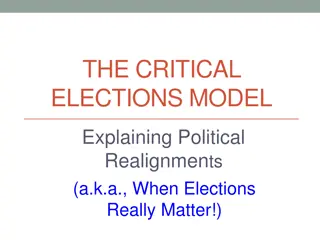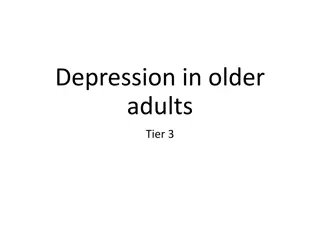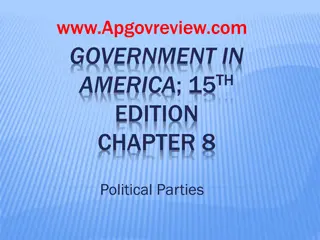The Fourth Political Party System: 1932-2014 - The Great Depression and Economic Realignment
The Fourth Political Party System in the US, spanning from 1932 to 2014, was significantly influenced by the Great Depression. Factors like the boom in road construction, the housing industry, and the stock market bubble led to economic turmoil. Key figures like Herbert Hoover expressed optimism before the crisis hit, highlighting the complexities of the era.
Download Presentation

Please find below an Image/Link to download the presentation.
The content on the website is provided AS IS for your information and personal use only. It may not be sold, licensed, or shared on other websites without obtaining consent from the author.If you encounter any issues during the download, it is possible that the publisher has removed the file from their server.
You are allowed to download the files provided on this website for personal or commercial use, subject to the condition that they are used lawfully. All files are the property of their respective owners.
The content on the website is provided AS IS for your information and personal use only. It may not be sold, licensed, or shared on other websites without obtaining consent from the author.
E N D
Presentation Transcript
The Fourth Political Party System: 1932 - 2014 The Great Depression and the Initial Realignment
The Lead up to the Depression: 1) The Road Building Boom 1) As late as 1921 No Highway in the United States had a Number. 2) Chains on all 4 Wheels and a shovel with a collapsible handle were necessary equipment for all cars. 3) Between 1921 and the Depression Government expenditure for Streets and Highways exceeded the capital outlays for most Private Industries. 4) These expenditures were a "Hidden" Subsidy for the Automobile Industry and had the effect of Stimulating the Economy in general.
The Lead up to the Depression: 2) The Housing Industry 1) Housing Construction boomed between the end of World War I and 1926. After 1926 it slowly dropped off. 2) Rapid Population Growth and Pent-up Demand because of WWI produced strong demand. 3) The Fact that Real Wages were not Rising as fast as Productivity Suggests that Demand for Housing was Exhausted by the late 1920s.
The Great Bubble: Suppose You had $100 to invest in the Stock Market in July 1926 July 1926 $100 July 1927 112 July 1928 148 January 1929 193 September 1929 216 December 1929 147 December 1930 102 July 1932 34
1) Many People and Corporations had bought stocks on Margin from Brokers -- usually 10% down and 90% borrowed. 2) Brokers in Turn borrowed Money from non-Bank Sources. Many Corporations invested their Surplus Profits in these Endeavors. 3) The Bubble was also Fueled by Investment Trusts. These sold their own debt instruments and then used the money to buy stock. 4) The craze became so Intense that it looked like it could go on forever.
Herbert Hoover (early 1929): "We in America are nearer to the final triumph over poverty than ever before in the history of any land ... We have not reached the goal, but given a chance to go forward with the policies of the last eight years, we shall soon with the help of God be in sight of the day when poverty will be banished from this nation."
John J. Raskob (Chairman of the Democratic Party, Summer 1929): "If a man saves $15 a week, and invests in good common stocks, and allows the dividends and rights to accumulate, at the end of twenty years he will have at least $80,000 and an income from investments of around $400 a month. He will be rich. And because income can do that, I am firm in my belief that anyone not only can be rich, but ought to be rich."
ECONOMICS Unemployment GNP Consumer Prices Manufacturing Investment Stocks 1929 3.2 104.4a 73.3b 58b 16.2c 260.2d 1930 8.7 95.1 71.4 48 10.3 210.3 1931 15.9 89.5 65.0 39 5.5 136.6 1932 23.6 76.4 58.4 30 .9 69.3 1933 24.9 74.2 55.3 36 1.4 89.6 1934 21.7 80.8 57.2 39 2.9 98.4 1935 20.1 91.4 58.7 46 6.3 106.0 1936 16.9 100.9 59.3 55 8.4 154.7 1937 14.3 109.1 61.4 60 11.9 154.1 1938 19.0 103.2 60.3 46 6.7 114.9 1939 17.2 111.0 59.4 57 9.3 120.6 1940 14.6 121.0 59.9 66 13.2 110.2 1941 9.9 138.7 62.9 88 18.1 98.2 a $ Billions in 1929 Prices. b 1947-49 = 100 base c Gross Private Domestic Investment ($ Billions) d Average Prices of Stocks (1941-43 = 100)
Four Distinct Periods: a.1930 - 1933: Steep Decline b.1933 - 1937: Steep Recovery c.1937 - 1938: Recession d.1938 - 1941: Tooling up for World War II
Initial Realignment of Various Groups 1930 - 1937 DEMOCRATS 1) Lower to Lower Middle Class -- In Particular the Working Class (Especially Urban Areas) 2) Lower Income in General 3) White Ethnic Groups: Catholics, Jews, Poles, Irish, Slavs, Italians 4) Organized Labor 5) White Southerners 6) New Voters -- Especially Immigrants who entered before 1924 7) Northern Blacks REPUBLICANS 1) Upper Middle to Upper Class 2) Middle to Higher Income in General 3) White Protestants 4) Business 5) Professionals 6) Southern Blacks
Summary -- Realignment of the 1930s (to late 1930s) -- Neither Party Replaced 1. Breadth and Depth of the Underlying Grievance Economic Disaster. Sudden and Unexpected and the Republicans were blamed for it. 2. Capacity to Provoke Resistance Haves vs. the Have Nots. 3. Leadership Lagged Behind the General Public. The Republicans were unable to adapt. 4. Division of Polar Forces Between the Two Parties Affected Mainly the Republicans. They were Reduced to a fraction of their former Support. 5. Strength of Existing Party Attachments Strong, but overwhelmed by the sheer Magnitude of the Economic Disaster.
SUMMARY Realignment of the 1930s (to late 1930s) -- The Realignment Scenario Clearly Type 2 -- Realignment in which Neither Party is Replaced. The System Stays in State A With a Dramatic Shift of the Electorate to the Democratic Party.























